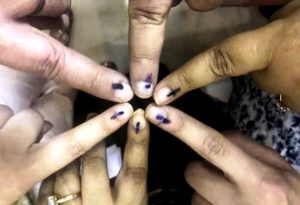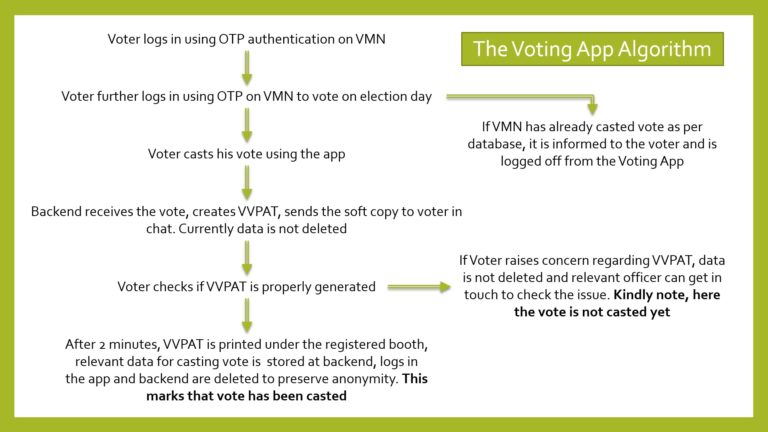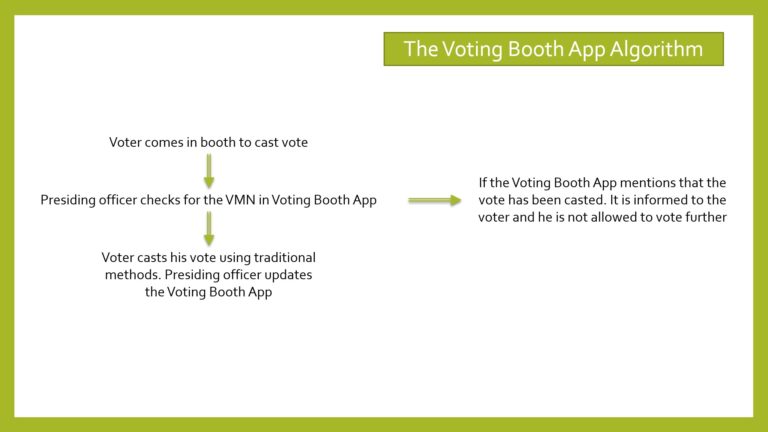eVoting – Solution to increase the Voter Turnout
-By Sagar

Summary
Recent elections show that in India almost one-third of the population doesn’t cast its vote. This can be devastating for India’s democracy. We can increase the voter turnout by increasing the convenience of voting by introducing eVoting. It is an app-based solution which will allow citizens to cast their vote remotely via their smartphones.
The article talks in detail about the architecture of the solution, ie, how 2 apps, the Voting app and the Voting Booth app, along with the backend, can be used to implement the whole voting process. If implemented properly, the solution can result in increased voter turnout, reduced motivation for booth capturing, and increased efficiency and precision in the whole voting process.
However, we need to be careful of the challenges that we might face in the deployment of this voting method. Key challenges are cyber-security and gaining trust from the various stakeholders. If appropriate remedies & mitigations are taken in implementation, then eVoting can prove to be a huge boost for democracy in India.
Statement of Need
As per ECI, in 2019 Lok Sabha elections, the overall voter turnout was recorded at 67.40%1, where voter turnout of 23 out of 37 states/ UT fell between 55% to 75%. A similar trend can be observed in past elections since 1998 where the voter turnout looms around the 60% mark2. Even for the state assembly elections, the overall voter turnout for all elections since 2019 is 67.36%3. This means almost one-third of the population, in general, do not exercise their right to vote.
This comes with its own problems. Low voter turnout implies that the population is not accurately represented and eventually policies of the whole country are decided only by a fraction of the country’s population. This, in turn, means that those who vote ultimately decide the direction in which the country should move, even though that direction may not be beneficial to all fellow countrymen. This can lead to elected politicians who only have major campaign donors, such as corporations or wealthy citizens, on their minds, and pass policies that match the goals of those major donors. Overall, it can be devastating for democracy4.
So, why does an eligible voter choose not to vote? As per “An Economic Theory of Democracy” by Anthony Downs, the basic formula5 for determining whether someone will vote, on the questionable assumption that people act completely rationally is:
P*B + D > C,
where,
- P is the probability that an individual’s vote will affect the outcome of an election,
- B is the perceived benefit that would be received if that person’s favoured political party or candidate were elected,
- D originally stood for democracy or civic duty, but today represents any social or personal gratification an individual gets from voting, and
- C is the time, effort, and financial cost involved in voting
The left-hand side of the equation is dependent on the voter’s individual perception, but the government’s policies can control the right-hand side. By making the process of voting less cumbersome, less time-consuming and more intuitive, the government can reduce the time, effort and financial cost involved in voting by an eligible voter, thus increasing the voter turnout.
The Government of India has already realised it and within a short span of 20 months has developed a suite of 20 web and mobile-based applications6 keeping various stakeholders and phases in mind. To this suite, I suggest another app-based solution which will further ease the convenience of voting by allowing voters to cast their vote remotely via the internet from their smartphone itself – eVoting.
The Solution
The solution comprises 2 apps – one for the voter, another for the presiding officer at each voting booth. Apart from the functionalities of the app, we also need to discuss the information that is being stored in the backend to preserve anonymity and sanctity of the eVoting process. In this section we talk about all the three points, along with some prerequisites:
Pre-Requisites
Currently, Election procedures work on the basis of Voter IDs, and mobile numbers are linked with Aadhar Cards. For this solution to work, we need to link Voter IDs to Aadhar Cards, such that each Voter ID has a corresponding and unique mobile number. For our discussion, we will call this mobile number as Voter Mobile Number (VMN)
The Voting App
General Login
Each user will have to log in using his VMN and authentication will be done using a One-Time-Password (OTP) sent to the mentioned VMN. The app’s backend should not allow a VMN to log in through multiple devices at any single point of time.
Login on Election Day
After logging in, the app will automatically check whether VMN has an ongoing election or not, based on the current date and constituency of VMN. If the current date is an election date for the VMN and the VMN has not cast its vote already, then voting will be enabled. If the user selects to vote, another OTP authentication will be required. Once authenticated, the user will be able to see all the candidates and then can cast his vote.
Casting Vote
Once the voter has decided among the candidates available, s/he can select that candidate to cast the vote. After confirmation of the vote, the details of the vote which include the VMN and the candidate chosen is sent to the backend.
Voter Verified Paper Audit Trail (VVPAT) Generation and 2-minute window
After receiving the vote details, a soft-copy of VVPAT will be generated and sent to the user using a chat functionality in the app itself. This will mark the beginning of a 2-minute window where the voter can raise any complaint if s/he believes the vote has not been captured properly.
App and backend processes if the voter does not complain
If the voter does not complain, this chat containing the soft-copy of VVPAT will be there in the Voting App for 2 minutes, after which it will be deleted permanently from the App as well as from the backend (something similar to Snapchat). Simultaneously, from the app, any logs in the app which recorded the activities performed during the voting process will also be deleted. At this time, the VVPAT is printed in the booth under which the VMN is registered, marking the casting of vote.
App and backend processes if the voter chooses to complain
Within the 2-minute window, the voter has an option to flag any discrepancy using options mentioned in the app itself. If s/he chooses to highlight any discrepancy, the logs and VVPAT will then be stored in the app and can be viewed by an authorized ECI commissioner to resolve any query. Kindly note that in this case, the vote has not been cast.

The Voting Booth App
The voting booth app with the presiding officer at the booth will be used to check which VMNs have cast their vote, offline or online. It can be logged in using authorized credentials and will have the database of all the voters expected to vote from that particular booth. If anyone casts a vote online, it will be simultaneously updated in this app. For offline voting, it will be the presiding officer’s duty to update the app. This will avoid multiple votes from a single Voter ID.

Backend
In the backend, it is to be ensured when an online vote is received from a VMN and the 2-minute window has elapsed, both the VMN and the vote are stored separately and no such link is stored, which can map the VMN with vote cast. Without getting deep into technicalities, items such as logs, timestamps, etc. should also be deleted once the 2-minute window has elapsed.
The backend will not only serve as a repository for storing votes, but it will also serve as a check to ensure multiple votes are not cast from a single voter, be it online or offline. Hence it is important to store the VMN separately.
Benefits
Increased Voter Turnout
One of the major benefits of this solution is that it increases the voting convenience manifold. All the voter needs to have is a smartphone with a stable internet connection and all the voter needs to do is install the app from the respective iOS or Android App Stores. The voter will be able to cast the vote just like any financial transaction or online shopping transaction using OTP. If everything goes well, it should take a maximum of 2 minutes to cast the vote. There will be no venturing out, no risk of getting caught in violence/ booth capturing, no standing in queues, no ink marks or any other hassles involved with offline voting.
Reducing motivation for booth capturing
Another by-product of this approach will be that it will reduce the effect of malpractices such as booth capturing. Currently, if a booth is captured, all those who would have voted before booth capturing would have voted as per their choice, whereas for all others, their vote is compromised. Hence, if the speed of the vote casting process is increased then we can ensure maximum authentic votes. However, the offline voting process has a bottleneck created at voting booths and the speed of the process cannot be increased. But with the online voting process, theoretically, the whole process can be finished within 2 minutes of commencing of voting, thus giving no scope for such malpractices. Hence reducing motivation for conducting any such activities.
Efficiency and Precision
Usage of technology will further reduce the organization and implementation costs thus increasing the efficiency of the whole voting process. Also, it will reduce any manual effort involved in current voting process thus eliminating human errors.
Challenges
Cyber-Security
One of the major challenges of e-voting is that when you get anything online, you will have to deal with cyber threats. There can be multiple loopholes in the system which can be exploited by hackers. There can be malicious software in the end-point devices which can exploit vulnerabilities in the Voting app to modify the votes. If carried out on a large scale, it can change the outcome of the whole election. However, we can overcome this to a major extent by deploying state-of-art security measures, employing ethical hackers to find out vulnerabilities in the whole ecosystem, and other best practices involved in the cyber-security domain.
Trust
Whenever a new process is introduced, it is observed that people are a bit resistant in accepting change. Also, because of the security challenge, people may be reluctant to adopt e-voting readily. Another inhibiting factor can be that people will not be sure if their vote is actually anonymous or not. To counter this, a demonstration of this process needs to be done to gain the trust of all the stakeholders involved. We will talk about this in detail in the Implementation section.
Implementation
Demonstration
Once the system is developed, multiple demonstrations need to be conducted to gain the trust of the stakeholders, which are as follows:
- Gaining the trust of political parties: A closed-group demonstration needs to be done, where it is already known which participant will cast a vote to which candidate so that the result can be tallied and accuracy can be verified. Along with VVPAT, this demonstration can lead to gaining trust in the whole system by the political parties
- Gaining the trust of citizens: Once the political parties are taken in confidence, we can hold a mockup election in certain constituencies. During this time, ethical hackers will also be employed to check for any vulnerability in the process. Once all votes are cast, the database of the whole process should also be made public to prove that anonymity and sanctity of the voting process is maintained
Real-Time Election Deployment
Once these demonstrations are completed and any improvements (if required) are made to the system, we can deploy this system initially for lower-stake elections, such as an election for members in Local-Panchayat or city corporation councils. It should be noted that the current voting mechanism through EVM machines in voting booths will run in parallel with the e-voting process. Just like postal votes, e-voting will be another medium through which votes can be cast. If the performance is satisfactory, we can then move on to higher-stakes elections, one by one. Gradually, we can include this medium in all the elections going forward.
Cost for development and implementation
Based on inputs from technical experts a moderately complex app can be developed within INR 10 lakhs, inclusive of the hardware costs. Considering the cyber-security required and huge database, we can safely assume that the development of the whole system will be done within INR 20 lakhs. Yearly maintenance of the app can consume around INR 5 lakhs yearly. Once the app ecosystem is developed, there will be an additional cost for spreading awareness during demonstrations and during elections. There is a negligible cost for the usage of the app in an actual demonstration/ election scenario.
Conclusion
With technology now becoming a guiding factor in the progress of the nation, we should give the technology a chance to prove its worth in the voting process as well. As mentioned in the article, if e-voting is implemented along with traditional voting methods, it promises to increase the voter turnout significantly. Along with that it also suggests that it will result in lower instances of booth capturing and increased efficiency and precision. However, we must be cautious of the cyber threat and the social aspect of introducing this medium. If the implementation of the whole process is carefully planned then we can witness a huge increase in voter turnout thus making the biggest democracy in the world even greater.
References
1 - https://eci.gov.in/files/file/10971-12-state-wise-voters-turn-out/
2 - https://www.deccanherald.com/national/national-politics/voter-turnouts-in-lok-sabha-elections-since-1952-730438.html
3 - https://eci.gov.in/statistical-report/statistical-reports/
4 - https://tmn.truman.edu/blog/editorial/opinion-low-voter-turnout-has-consequences/
5 - https://en.wikipedia.org/wiki/Voter_turnout
To read other articles related to Covid-19, Click here
To read other Literary articles, Click here
To read other articles on this website, Click here